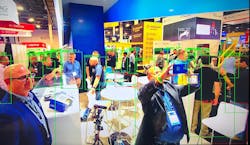Energy transition in security: gridless power, ultra-high performance, ultra low power IP video
The far-reaching energy goals in 2022, driven by acute energy needs, are now being translated into policy. Practitioners are creating energy governance policies that set carbon footprint reduction goals in their operations.
Solution providers are translating these policies into action. Technology using renewable energy sources, their stored energy and ultra-low power processing devices are moving to the head of security, public safety and facility operation budgets.
These activities scale to protect energy supplies around the world and contribute to “energy security.”
Gearing Up for ESG
Practitioners in North America are gearing up to improve ESG (environmental, social, and governance) performance and pursue net-zero carbon emissions. This is emerging as a new blue ocean market for industrial security and public safety system suppliers.
Ford and Apple are two examples of companies that created their blue oceans by pursuing high product differentiation at a relatively low cost, which also raises the barriers for competition.
Energy transition and zero-emissions technology are one offshoot of a “productive” ESG. But how does this translate into security and public safety’s blue ocean?
There are five current opportunity categories, and more will emerge as energy storage competes with energy collection.
First, some solutions deliver power directly, and that energy is created and stored from low carbon footprint sources. Second, devices containing ultra-low power central processing units (CPUs) that, together with ultra-low power AI processors, are capable of performing high-terra operations per second (TOPS). They are a solution delivering analysis at a fraction of the power of legacy analytics systems.
A third category is monitoring events threatening the environment or clean energy sources, which is a critical requirement as energy transition proceeds. Fourth is monitoring publicly recognizable emergencies, such as an active assailant, and responding to them efficiently and responsibly.
The fifth category is the amazing “zero power” components, devices and systems capture and convert energy “off the grid,” activating devices often without moving parts.
Blue Ocean Markets
At ISC West 2023, Epic IO demonstrated Deep Insights, a product with high differentiation across public safety and retail markets that is deployed it in the city of Riverbank, Calif.
“We meant to have more diverse monitoring of our community, not 24/7 monitoring -- but also smart-enough technology allowing us to respond to critical incidents,” says Sean Scully, city manager of Riverbank.
Adds Ed Ridenour, Riverbank’s police chief: “We ultimately implemented a fairly comprehensive city-wide license plate reader system on almost all major intersections and entrances and exits to the community, and the ability to read license plates that we can go back and use to solve crimes. It’s been very successful in solving a lot of our retail theft crimes.”
“One of the unique ways that the camera system helped the community was with safety, which is not always related to criminal activity. For instance, we had an elderly woman with dementia that left her residence and didn't know where she was going.
“We used the camera system to track down her license plate and locate her within about an hour and a half, getting her back to her family and the help she needed.”
Here, the LPR solution virtually eliminated a vehicle-based investigation, lowered the carbon footprint and contributed to energy transition.
Energy transition begins with lighting
At ISC WEST 2023, there were many providers of visible, semi-covert and covert IR LED lighting systems, all at improved power consumption and in production.
At CES2023, Micropower Collection Design & Technology (MPC) took “off the grid” further, introducing “zero power” pre-production pathway security and architectural lighting, visible for about a mile, completely illuminating a multi-floor structure from buried energy cells of organic waste.
“We don’t need the big power for big lighting. This LED lighting is enough. We will be able to set up underground cells for continuous path lighting and even highway illumination. Safely illuminating a country’s coastline is most likely the first use by the U.S. and Japanese Coast Guard.”
The production of low-power product opportunities presented at ISC West will give way, eventually, to some devices not requiring a local battery as power source, as first reported by SecurityInfoWatch.com at this year’s Consumer Electronics Show (CES).
Unlocking Without Continuous Power
Christina Offenzeller of the Stiwa Advanced Products Group, a massive conglomerate of cross-industry business units, demonstrated a zero-power lock. Stiwa estimates total energy costs may be reduced by up to 30% through building automation and energy conservation technologies.
“This is a completely passive device,” Offenzeller says. “If you want to unlock this panel, you open a secure app on your phone, hold it on the lock, it unlocks, and as soon as you move the phone away, it loses power. When we’re finished it will be NFC. At the moment we’re aiming for mobile solutions, last mile delivery, pickup stations in front of large buildings, but doors will be a possibility. The lock doesn’t require any cables or power supply, as it receives power from the phone.”
This is a breakthrough for many industries requiring cost effective locking devices to secure goods that need to travel tracked and secure. Cannabis growers often have a choice of securing goods in the preparation and packaging areas or deploying a video surveillance system. The Smalox zero power lock flips that choice.
The perspective on production energy transition access control differs, but not for long.
Just two months before the Smalox zero-power lock introduction, keyless lock operation continued to be debated on several forums. One statement read, “Opening a wireless lock remotely is impossible without a continuous power source. That’s why a battery-operated lock can be opened remotely using Bluetooth gateway, so people accessing a site won’t have to carry the right type of smartphone to open a lock.”
Energy transition technologies will continue to challenge ‘absolute’ statements like these. Established best practices will give way rapidly to ESG-friendly, blue-ocean developments across industries.
Meanwhile, low-power locking technologies continued to advance at ISC West, where ASSA ABLOY introduced the Medeco eCLIQ intelligent key system, which the company says provides retrofit without wiring into existing doors and locks, along with improved physical security and a high degree of encryption.
A non-mechanical key blade includes a 10-year embedded battery that powers the electronics in the cylinder, Bluetooth, and a water resistance rating of IP67.
The impact of improved power systems for the planet are significant. A simple 2% efficiency gain in power systems across the world can present an equivalent opportunity to reduce CO2 emissions generated by 97 coal-fired power plants.
The entry of no-power security and safety lighting and locking technology at CES 2023 contribute to reasonable and desirable energy transition.
Energy Storage Stabilizes
Variable Energy Demand
At ISC West, Gridless Power made the case for a compelling energy transition model with their modular and solar powered intelligent battery systems. During the Rhythm and Brews Festival in New York City, Gridless demonstrated how a small 7,000-watt (W) battery system competed with a 20 kilowatt (kW) generator to reliably power complex audio equipment.
The average power draw at the event was around 1,000W, with dramatic peaks and valleys common for a concert event. To accommodate a 20kW spike in power needs, a 20kW generator is required. Because batteries discharge power at a wide range of levels on command, you can use a battery with a low inverter output and a high surge rating.
Conclusion: use one or many battery module groups to more cost effectively bring reliable electricity to remote areas. These “swarm grids” are being used to reliably deliver power during disasters in Ukraine, Africa and after weather events.
The Gridless product line includes Core, Hotspot, WiFi Node, or as exhibited at ISC West, the Gridless Sentry with power for IP cameras, 5G communications, an intelligent battery management system (BMS) and energy storage.
Even at high charge cycles (5,000), the Gridless Core and Sentry battery storage will still retain 75-80% of their original capacity and have very little loss during the recharge process, making this an easy decision for most surveillance needs not attached to a building structure having an existing low carbon energy source.
Gridless energy storage products have been used for disaster relief and military applications by customers like Amtrak, cities of New York and Philadelphia, and the Department of Homeland Security. The Metropolitan Transit Authority’s (MTA) recently used Gridless power for disaster response training as readiness for rescue after a train crash.
4K Solutions is a Gridless Power Systems integrator that recently received a contract of significant size for 5G Mobile Broadband Kits (MBK) in support of an international partner force, with the primary responsibility for defending their homeland overseas. These MBKs can support a diverse variety of terrestrial and satellite communications.
Gridless Power Account Manager Maredyth Daily demonstrated one of many Gridless Sentry IP Camera/Communications/BMS configurations for SecurityInfoWatch at ISC West. She showed a power and communications box “all in one.”
“It’s as easy as connecting with your local cellular provider by popping in a SIM card in the cradle-point device and you have connectivity. All our units are customizable based off deployment, as well as customer needs.”
Daily says the Sentry is fitted with Verkada IP cameras, allowing both a power grid and surveillance system matched and managed, cloud to cloud. The Sentry can be designated for use with intermittent power with solar panels.
Ultra-Low Power Processors, Appliances
The demand for recognition of multiple, complex objects using different algorithms places extraordinary demands on visible light, thermal cameras, LiDAR and sensor fusion arrays.
These functions would have previously required multiple, legacy IP cameras or other sensors, scaling to significant power consumption.
At both ISC West and CES, a significant trend continued where analytic functions are performed more efficiently by ultra-low power AI processors. These AI processors can perform high terra operations per second (TOPS), allowing lower-cost Central Processing Units (CPUs) to be selected. This combination delivers analysis at a fraction of the power and cost per channel of legacy analytics systems.
The Hailo 15 AI Processor demonstration display at ISC West had so many analytic “bounding boxes” displayed on a single screen -- complete with recognition percentage, type of algorithm used and processor status -- that booth visitors had to stand close to read all the details rendered.
At the Lanner Electronics booth, their small-form-factor Edge AI Appliance LEC-2290 is the approximate size of a small industrial WiFi router, but functions as a complete processing appliance supporting wired and wireless LTE, CBRS, FirstNet and WiFi.
The CPU is paired with the top-of-the-line Hailo-8 AI processor, featuring up to 26 TOPS -- significantly outperforming other edge processors at ultra-low power levels by a considerable order of magnitude (up to 3 TOPS/W). The demonstration display had 12 windows, each with multiple object recognition algorithms in use.
It should be noted that AI processing is not limited to visible light IP camera streams. In fact, the Edge AI appliance could easily apply algorithms to 3D LiDAR point clouds, 3D Monocular Sensors, like OwlAI, or even simple radar “blobs.”
The application of algorithms to stream processing is a function of software, and simplified by those in Lanner and Hailo’s partner network, which includes the likes of Gorilla Technology, AllGoVision, Art of Logic, Innovatrics and CVEDIA.
Himax a low-power image recognition and semiconductor products company, introduced at ISC West the WiseEye smart image sensing platform, specifically designed for battery-operated home and office surveillance, and entry doorbell functions.
Himax uses a similar concept of CPU (iCatch) and AI processor (WiseEye) as Hailo and Lanner, but on an extremely small scale, and taking direct aim at Ring with a sophisticated pre-roll feature and estimated 2-month battery life.
This is made possible by two sets of image sensors, one for black-and-white pre-record and full color for motion events. The Everspring indoor PIR may also be used to reduce false alarms further, achieving an estimated 50% reduction in power. This is consistent with a comparative, typical Ring camera or doorbell battery life of one month.
More Power to the Robots
In robots, locomotive subsystems typically have the highest power consumption. When there is an opportunity for the imaging and AI processing subsystem to be ultra-low power, it means a longer interval between charges.
Luxonis received a CES 2023 Innovation Award for the powerful OAK-SoM-Max, a “System on Module” (SoM) designed for integration into top-level systems with a need for lower-power, high performance, real-time AI, and depth perception.
This aligns with the strong industry trend of putting more power, and the established DepthAI API, into a wide range of use cases where the SOM’s feature set can help scale robot deployment. Some of these use cases are healthcare vitals monitoring for newborns, construction sites and road worker safety.
Lower Carbon Footprint with
Communications and Infrastructure
Zenitel has a remarkable wide range of communication systems with ONVIF and Homeplug interoperability and Session Initiation Protocol (SIP), enabling Voice Over Internet Protocol (VoIP) in maritime and outdoor harsh environments.
At ISC West, Zenitel introduced their Flowire product range, based on the HomePlug AV power line communications specification, using a single-paired cable to distribute power and data five times the length of ethernet, reducing appliances and overall system power consumption.
Up to nine Flowire devices may be connected on a single run, lowering the carbon footprint even further.
Zenitel also has a Safe Return to Port Solution, a secure wireless UHF communication system that meets the requirements of the SOLAS (Safety of Life at Sea) SRtP regulation. This reduces the time, automates processes and therefore power used during offshore emergencies.
Steve Surfaro is Chairman of the Public Safety Working Group for the Security Industry Association (SIA) and has more than 30 years of security industry experience. He is a subject matter expert in smart cities and buildings, cybersecurity, forensic video, data science, command center design and first responder technologies. Follow him on Twitter, @stevesurf.
About the Author

Steve Surfaro
Steve Surfaro
Steve Surfaro is Chairman of the Public Safety Working Group for the Security Industry Association (SIA) and has more than 30 years of security industry experience. He is a subject matter expert in smart cities and buildings, cybersecurity, forensic video, data science, command center design and first responder technologies. Follow him on Twitter, @stevesurf.



